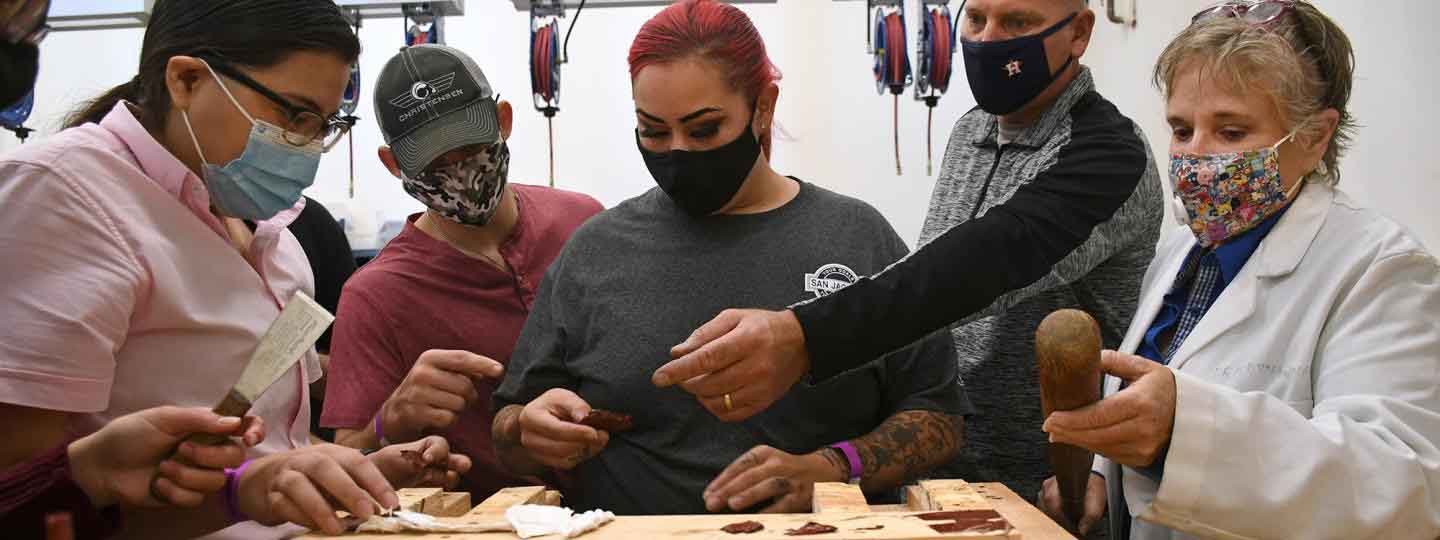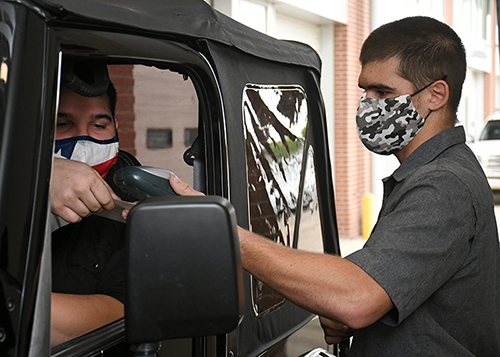Despite new lab, shiny technology, criminal justice program stresses people skills

"561-Traffic. Location: 3501 Luella. I have a black Jeep, two doors, license plate Frank-George-Henry-1234, clocked at 75 in a 40-mph zone."
Walkie-talkie in hand, the officer strolls up to the pillar by the Jeep's driver-side door.
"I'm Officer Gonzalez," he says, calm, professional. "You were going 75 in a 40-mph zone. Is there a medical reason you were speeding — an emergency?"
The driver shakes his head. "No, sir."
"Can I see your driver's license and proof of financial responsibility?"
Although a familiar scene on the streets, this traffic stop is taking place with San Jacinto College students in the new crime lab. At 1,300 square feet, the Central Campus criminal justice program lab has expanded training options — from processing vehicles for evidence to conducting blood spatter analysis and full crime scene investigations.
Trading spaces
This fall, criminal justice traded labs with the automotive technology program. In exchange for its smaller lab, criminal justice got one of the auto program's larger labs with a garage door for bringing vehicles in and out.
"It's perfect for our needs," Dr. Robyn Ring, criminal justice professor, said. She refers to rows of worktables with storage underneath and shelves hugging the walls, some layered with training dummies. "We have the bunk house for the dead — shelving for all the bodies."
The lab not only expands storage space but also allows more in-depth crime scene training. Ring says much criminal evidence processing happens through vehicles. Now students can practice real-world techniques like powder-dust processing several vehicles inside the crime lab to search for evidence.
This is a second step in advancing criminal justice training at the Central Campus. In 2019, the program moved to the campus' Automotive and Career Center. In this limited-access building away from heavy foot traffic, the program has more options for outdoor crime scene training and indoor night searches.
Criminal justice professor John White says crime scenarios in more open settings used to attract gawkers: "People would ask, 'Why are bodies lying around?'"
Getting feet wet
While students in Traffic Law and Investigation practice traffic-stop scenarios, students in Criminalistics II spread out around the crime lab to practice preserving evidence.
Three students unroll 20 feet of butcher paper across the floor. They ink the tread of a tire, then roll the tire the length of the paper to capture its footprint. Across the room, Andrea Hernandez and two teammates use casting putty to fill in dents made by a blunt object to a wooden pallet. After the putty hardens, they peel it back to reveal the imprints.
"I have always had a strong interest in the criminal justice world — from crime scene investigations to solving cold cases," Hernandez said.
The new space offers her hands-on training in both crime scene techniques and traffic law.
"The setting of the labs gives us students a more realistic view of real-world situations rather than reading it out of a book," she said. "It's never a dull moment."
What used to be a male-dominated field at San Jac now boasts almost 50% women, with many pursuing police work. Hernandez aims to become a juvenile supervision officer and later correctional counselor in detention centers: "I plan on making a difference to help rehabilitate our youth before they become career criminals as adults."
Promoting people skills first
After a season of mainly online learning because of COVID, criminal justice students enjoy returning to hands-on training, especially in the new lab. They also get to use handheld doppler radar units to practice traffic enforcement and — after it's calibrated — a shooting simulator to practice instant decision-making.
"You're not going to make them experts when they leave, but you're going to expose them to things a normal community college class doesn't have the ability to," Ring said.
Regardless of new space or shiny technology, Ring and White — both retired from law enforcement — say the program focuses first on service to the community and people skills. Because 80% of an officer's job is communication, students learn how to de-escalate situations.
"Some of our students have a better grasp of things than those who leave police academy," White said.
"Criminal justice is common sense and good judgment," Ring added. "Policing is about social service. It's a people job. If students don't have people or life experience, they've got to get it."

